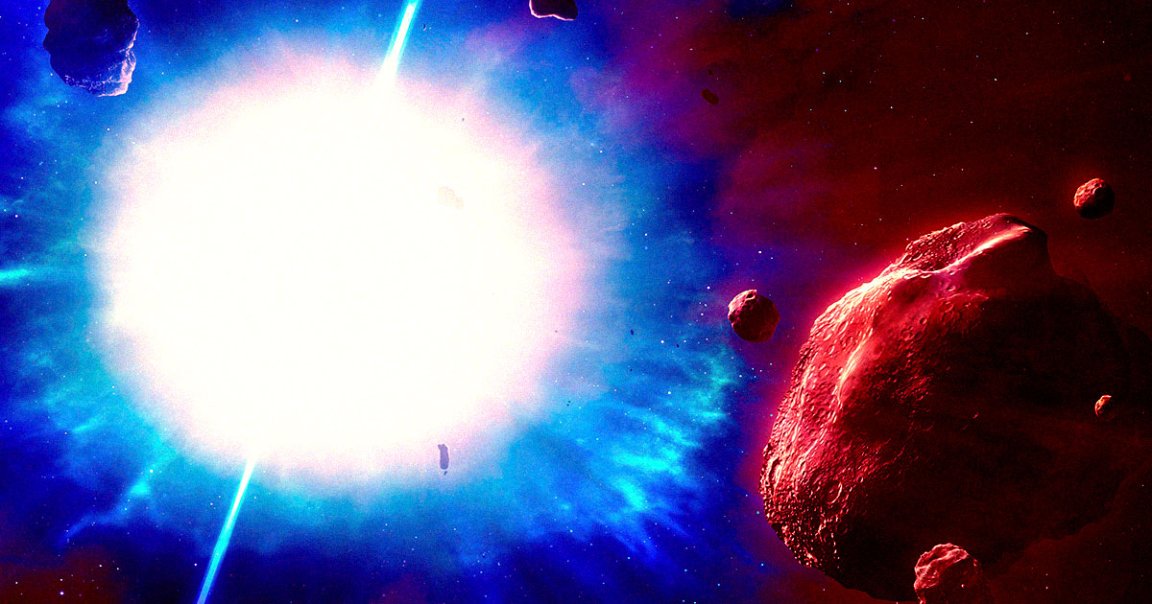
For almost two decades, astronomers have been trying in vain to explain extremely bright flashes of radio bursts emanating from deep space.
Despite only lighting up for a tiny fraction of a second, these fast radio bursts (FRBs) have been known to release as much energy as the Sun puts out in an entire year.
Now, in what’s being called a “turning point,” an international team of researchers has traced back the location of the origin of one of the brightest FRBs ever detected, allowing them to glean invaluable insights into the baffling phenomenon.
As detailed in a pair of new papers, astronomers used the Canadian CHIME/FRB radio-telescope to home in on an FRB, officially called 20250316A — but unofficially referred to as “RBFLOAT” for Radio Brightest Flash Of All Time” — which was first observed in March of this year near the Big Dipper.
Thanks to an array of “outrigger” telescopes spread out across North America, the team was able to pinpoint the origin of the FRB to a precise region that measures just 45 light-years across, significantly smaller than the average star cluster, in a galaxy some 130 million light-years away.
While that may sound somewhat overwhelming, given the fact that 45 light-years is roughly 30 times the diameter of our entire solar system, it’s an impressive feat.
“The precision of this localization, tens of milliarcseconds, is like spotting a quarter from [62 miles] away,” said lead author of one of the papers and McGill University-based postdoctoral researcher Amanda Cook in a statement. “That level of detail is what let us identify the host galaxy, NGC 4141, and match the burst with a faint infrared signal captured by the James Webb Space Telescope.”
That kind of precision allowed teams to trace back the FRB’s origin to a faint infrared signal, which was previously captured by NASA’s James Webb Space Telescope.
“The high resolution of JWST allows us to resolve individual stars around an FRB for the first time,” said Harvard research associate Peter Blanchard, lead author of the second paper, in the statement. “This opens the door to identifying the kinds of stellar environments that could give rise to such powerful bursts, especially when rare FRBs are captured with this level of detail.”
“This was a unique opportunity to quickly turn JWST’s powerful infrared eye on the location of an FRB for the first time,” he added in a separate Harvard press release, calling the faint infrared source an “exciting result.”
“This could be the first object linked to an FRB that anyone has found in another galaxy,” Blanchard said.
Despite the exciting advancement, we’re still far from calling the mystery solved once and for all.
Researchers have previously suggested that magnetars, the extremely dense and highly magnetized remains of dead stars, or neutron stars, could be causing FRBs, sending powerful flashes of radio emissions at regular intervals like a lighthouse.
And that’s just one of many candidates that have been put forward over the years.
Complicating matters is the fact that the astronomers have yet to observe 20250316A repeating itself. Other FRBs have been known to repeat and pulse in complex and highly regular patterns, adding to the overall mystery.
“It seems different energetically than the repeaters we’ve studied,” explained McGill postdoc researcher and CHIME/FRB researcher Mawson Sammons. “We’re now re-examining some of the more explosive models that had fallen out of favor.”
The team posits that the object spotted in the JWST observations could be a red giant, a Sun-like star nearing the end of its life cycle. An accompanying neutron star could be pulling mass away from the red giant, a process that may have triggered the outburst of radio emissions.
“Dozens of different ideas have been proposed to explain FRBs, but until now we haven’t had the data to test most of them,” said coauthor and Harvard astronomy professor Edo Berger in the Harvard press release. “Being able to isolate individual stars around an FRB is a huge gain over previous searches, and it begins to tell us what sort of stellar systems could produce these powerful bursts.”
“Whether or not the association with the star is real, we’ve learned a lot about the burst’s origin,” Blanchard added. “If a double star system isn’t the answer, our work hints that an isolated magnetar caused the FRB.”
The team is already gearing up in the hopes of being in the right place at the right time to catch the next FRB in the act.
“We can’t predict when and where the next FRB will come from, so we have to be ready to quickly deploy JWST when the time comes,” Berger said.
More on FRBs: Scientists Propose Interesting Explanation for Mysterious Signals From Space